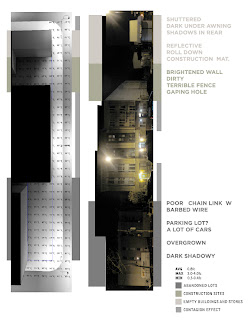 |
| fig. 24 Plan view of Site Interventions along a relamped Franklin Ave. |
Communities must recognize that neglect is a human behavior, which feeds into the negative perception that vacant properties often receive. The concentration of these properties along Franklin Avenue represents the opportunity to redefine this stretch in Crown Heights, Brooklyn.
After analysis, it was determined that each of the three typologies would address certain planar features that would become visibly apparent:
What is attractive about the project is the strategy that allows a community group or business improvement district to implement the intervention through low-tech means. Using linear strip fluorescent fixtures and modified construction materials allows laymen or construction workers to use the approach detailed below. Easy assembly allows the designs to be installed and disassembled after the property becomes transformed from its vacancy [Appendix B].
 |
| fig.25 Zoning Diagram |
 |
fig 26. Safety Orange is the visual color component in project (Photo courtesy of jphilipg on flickr.com) |
There is no gratuitous decoration for effect in any of its moves. Instead, its minimal reliance on additional structure permits the properties to bare their honest condition. Pedestrians know an eyesore when they see one. The desired reaction inspires one to capitalize on the opportunity at hand – the chance to implement a program that would positively contribute to the community. In order for these interventions to contrast with the streetscape, street fixtures adjacent to any vacancy would relamp from the current 250W HPS lamps to a lower wattage HPS – 100-150W [fig. 24].
As a result, an extraordinary sequence of illuminated planes would be revealed along the evening streetscape. The site’s twelve blocks divide into four zones. With timed controls, each zone will light intermittently over a 15-minute period at the start of each hour after dusk [fig. 25]. Drama unfolds as vacancies briefly reveal themselves and then return to their current status quo.
Moreover, the color, safety orange, plays a vital role in tying the project together. Safety orange is typically used in the United States for construction zones, traffic cones, barriers, and other signage devices [fig.26]. As a painted element, the color reinforces the transformative condition when orange light is relected onto highlighted surfaces.







